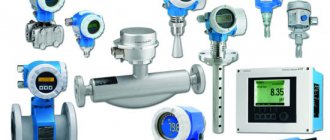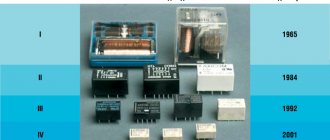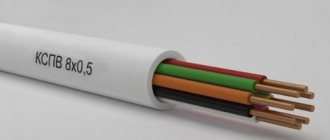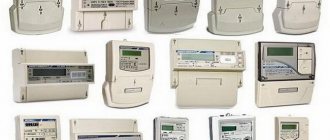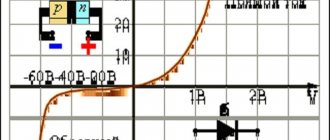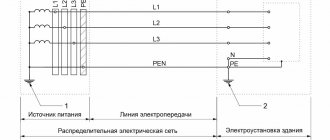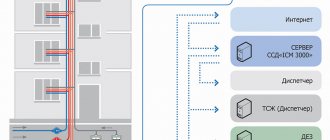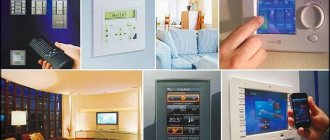A large amount of modern technological equipment is automated. These are pumping stations, boiler houses, power supply systems, and technological equipment. Process automation is often performed using microcontroller control circuits. But data collection for them is carried out by instruments and measuring sensors. Maintenance, repair, installation and adjustment of these devices is carried out by highly qualified specialists.
Classification of instrumentation
The abbreviation instrumentation refers to devices used not only in production, but also in other types of human activity - in science, healthcare and everyday life. All control and measuring instruments can be divided:
- by purpose (showing in place and recording);
- if possible, remote transmission of measured readings;
- by type of indication (analog, discrete, digital);
- by accuracy class;
- according to measured physical and chemical parameters (temperature, pressure, flow, level, concentration, humidity and density, electrical quantities, etc.).
Let's look at some devices that are divided depending on the parameters being measured:
- Instruments for measuring temperature - thermometers, thermometers, thermocouples, resistance thermometers, thermal imagers and pyrometers. Devices are digital, fluidic, electrical, electronic, infrared, contact and non-contact.
- Sensors for determining pressure - pressure gauges, pressure switches, analog pressure sensors and vacuum gauges. Pressure gauges vary in design - membrane, differential, electric contact, spring. An electrical analog signal when measuring pressure is usually obtained due to the tensoelectric effect - the property of solid materials to change their electrical resistance when deformed.
- Devices for measuring the volume of flow of a working medium (liquid, gas or other substances passing per unit of time) - flow meters. Depending on the principle of operation, the devices are electromagnetic, ultrasonic, including non-contact overhead, vortex, having various narrowing devices such as a diaphragm, tachometer and others.
- Devices for determining the concentration of certain substances in gas mixtures - gas analyzers, smoke analyzers, pH meters and steam analyzers. There are manual and automatic, stationary and portable. These devices are used to monitor air in the work area, to check industrial emissions, to monitor technological processes, to monitor gaseous media leaks, and to ensure fire safety.
- Tank filling level meters - level gauges. Used to measure the level of liquid and bulk materials in tanks, containers and storage facilities. Level gauges can be contact and non-contact, for example, buoy or float gauges, hydrostatic, ultrasonic, radar, interface level gauges, bubbling and other types.
- Instruments for measuring linear quantities. Rulers, tape measures, calipers, gauges, micrometers, depth gauges, etc.
- Instruments for measuring electrical energy parameters. Ammeters, voltmeters, ohmmeters, wattmeters, multimeters, etc.
- Instruments that measure radiation. These include Geiger counters, dosimeters and detectors.
- Instruments for measuring mass, hardness and density of materials. These are analytical and physical scales, hardness testers.
- Tensile, compression and torque sensors.
Purpose and structure
Instrumentation and automation is a set of interactions between certain objects and subjects, the main purpose of which is the measurement of physical quantities . Decoding instrumentation and automation sounds simple and accessible: instrumentation and automation.
The abbreviation Instrumentation and Automation clearly defines the technical and functional purpose of the system - it is the measurement and control of the value of a physical quantity and the automatic regulation of its constant value using instruments.
Structurally, this technical industry can be represented as follows:
- Instrumentation and automation in household appliances;
- instrumentation devices;
- instrumentation service.
Instrumentation and automation in household appliances
The constant improvement of large and small household appliances contributes to an increase in the need for the use of instrumentation and automation devices in the modern way of life.
Without instrumentation it is impossible to operate heating systems - boilers and radiators or microclimate and air ventilation systems (air conditioners and convectors). Electrical parameters - currents and voltages - are controlled in multicookers, irons, oil heating radiators, etc.
Microcontroller circuits, used in the automation of household appliances in conjunction with measuring instruments, open up the opportunity to easily monitor and regulate the operation of devices of various sizes and purposes.
Classification of measuring instruments
Systematization of measuring equipment is carried out in accordance with its physical and technical characteristics, taking into account qualitative and quantitative standards.
Classification of measuring instruments:
- Radiation measurements.
- Mass, hardness and density of a substance.
- Acoustic characteristics.
- Electrical and electromagnetic properties.
- Physico-chemical properties and composition of the material.
The name of a group of devices allows you to predefine the tasks they perform:
- thermometers, equipment for measuring and monitoring temperature conditions;
- pressure gauges, pressure control devices;
- flow meters, flow sensors of the working medium or other substances;
- gas analyzers, identification of gas mixtures and their structure;
- level gauges, indicators of volume filling level.
A separate group is divided into subgroups according to design and operating rules.
Let's say pressure gauges are devices that measure excess or absolute pressure, as well as record its change. In addition, pressure gauges differ in their electrical or mechanical design and operating principle. Let's also take into account the usual pressure switches and pressure gauges.
Thermometers are:
- liquid,
- with resistance conversion,
- thermoelectric,
- digital.
This group also includes pyrometers and thermal imagers.
More complex instrumentation equipment includes flow meters: they are used to determine the mass or volume of a substance. This group has a fairly wide range of models depending on the characteristics of the controlled area: thermal, vortex, electromagnetic, tachometer, ultrasonic, correlation and Coriolis, for measuring flow, with pressure drop, with level difference measurement.
The choice of group and device requires an individual approach, taking into account the operating conditions and properties of the measuring medium.
Tasks of the instrumentation and automation service
The main occupations of engineers and mechanics of the instrumentation and automation service are monitoring the serviceability of measuring and automation devices, replacing them with new ones or repairing them on site.
The uninterrupted operation of any technological process and the safety of operating personnel directly depends on the stability and accuracy of the operation of instrumentation and control systems. For this purpose, in large enterprises, specialized departments and teams are formed. The most efficient work of the unit is ensured by a staff that contains employees with highly specialized specialties.
For example, an installer of instrumentation systems must deal with installation, an automated control system technician must deal with elements of an automated control system, and the position of fire alarm engineer (interpretation: security and fire alarm) obliges him to service only the emergency warning system.
One should take into account the fact that interchangeability in the work of a well-functioning team is simply not welcome.
Small organizations need highly qualified personnel. The range of work responsibilities of a specialist, in addition to instrumentation and automation, includes the installation of video surveillance, telephone and alarm maintenance, etc. The reason for such additional workload is the constructive implementation of instrumentation and automation systems equipment, which is based on microelectronic elements.
The specifics of the work of the instrumentation and automation service simply obliges employees to be electricians or electricians, even beginners. Well, as a rule, the management of the enterprise is not averse to entrusting instrumentation specialists with responsibilities regarding the repair of computer equipment and software installation.
An example of a control and automation service is a gas pumping station. Controlling the station is not particularly complicated; monitoring the pressure and temperature of the working gas is important. Control and measuring equipment monitors the performance and safety of the section of the gas pipeline (between the nodes) and the compressor unit. The work of automatic control and diagnostic equipment, serviced by station personnel, is oriented towards this task.
Automation elements
In automated process control systems (APCS), various actuators are used to control the technological process.
Actuators are an element of an automatic system that acts on a control object to perform some action. Typically, actuators consist of two parts - an actuator and a regulator. The main purpose of actuators is to convert any signal (electrical, mechanical, optical, pneumatic) into signals to influence control elements (turning on, off, switching operating modes of mechanisms, systems or devices).
The most common actuators are switching relays, drives of moving parts, rotary devices, manipulators, electromagnetic valves (solenoids), devices for opening or closing control and shut-off valves and flaps, turning on variators and switching gearboxes.
Functions and tasks of instrumentation and automation specialists
The functions of the instrumentation and control department specialists are to ensure the operability and accuracy of the readings of all instrumentation and automated systems of the enterprise. The tasks of this department include monitoring the operation, adjustment and maintenance, repair and restoration of devices.
In the event of equipment failure, the Kipovets must react in a timely manner and replace the failed unit. The mechanic must conduct an inspection and, if possible, repair it within the department or at a specialized service organization. To do this, the instrumentation and control department must have spare parts, instruments and tools. Specialists of this department must conduct metrological supervision of measuring instruments to ensure the operation of all equipment. The instrumentation and control department belongs to the technical service of the enterprise and is functionally subordinate to the chief engineer.
Main activities when servicing boiler room automation
Diagnostic inspections and preventive checks make it possible to significantly extend the life of gas and boiler equipment. Employees of ENERGY & CO LLC perform:
- checking the serviceability of heat and gas instrumentation, control systems and adjustment of equipment parameters;
- checking the boiler room automation for compliance with the specified parameters;
- inspection of the condition of instrument housings, boiler equipment covers and insulation;
- setting up the operation of control sensors and adjusting them if the parameters do not correspond to the specified ones;
- checking the integrity of connections between individual elements of gas equipment;
- sending security system signals to the control room to monitor feedback.
As part of the maintenance of boiler room automation, the specifics of the building and the operating modes of the installations are taken into account. The timing of verification of devices is also monitored; if necessary, they are removed and sent to the metrological service.
Dismantling of individual devices during instrumentation and control equipment maintenance from their regular places and safe transportation to the verification point and back is carried out by qualified personnel of ENERGY and CO LLC.
Key specialists of the instrumentation and control department
At manufacturing enterprises, there are workshops or departments of instrumentation and automation. This service is led by the head of the department or workshop, sometimes these responsibilities are assigned to the chief metrologist of the enterprise. Instrumentation and control departments often include control and measurement laboratories (KIL). Depending on the type of production activity of the enterprise, the staff of the instrumentation and automation department also depends. But there is a minimum set of necessary specialists, these are:
- instrumentation engineer;
- instrument adjustment and repair technician;
- adjuster of instruments, equipment and automated accounting systems;
- mechanic for repair and adjustment of instrumentation and automation;
- electrical technician;
- radio electronic engineer;
For the efficient, safe functioning of modern engineering communications systems, it is necessary to provide these complex engineering complexes with specialized management and control tools and perform their high-quality installation.
Installation of bales and automation
To install such equipment, it is necessary to have various components: 1. Sensors, measuring instruments, actuators that monitor and control the functioning of mechanical components of the equipment;
2. Controllers that collect information from sensors that control actuators. Using algorithms, they ensure the maintenance of parameters and safe operation of equipment;
3. Means of feedback to the operator through user terminals or building management systems. For this purpose, communication gateways are used. Our specialists install bales and automation, regardless of their complexity. Installation of panels and systems is carried out according to the Customer’s designs, or according to projects developed by our specialists based on the Customer’s technical specifications.
Installation of automation systems will provide:
— Monitoring/control of the operation of units included in the equipment of air conditioning, heating, ventilation, etc. systems; — Indication of the equipment status in operating mode; — Equipment protection from supply voltage connection errors, short circuits, overheating; — Support and regulation of the desired air temperature; — Monitoring the working condition of air filters; — Independent ventilation system control algorithm; — Uninterrupted maintenance of operating equipment; — Supervisory control/management of basic parameters.
Cable system installation
The key to reliable operation of the cable system, which includes power supply, security, and communications, is its high-quality installation. Moreover, the requirements for the reliability of cable systems, their operational safety, and functionality are constantly growing. This is due to the development of modern technologies and the emergence of new high-tech materials.
It is difficult to imagine a modern building without a lighting and uninterruptible power supply control system, without local computer networks, conferencing, security systems and other communications. Other important life support systems of the building depend on the functioning of the cable infrastructure. Ultimately, this is an indicator of the degree of its comfort and functionality.
Carrying out an integrated approach to the process of installing power and low-current networks, our specialists optimize the routes for laying cable systems, taking into account the electromagnetic compatibility of the equipment. As a result, the reliability of the system increases, its maintenance is simplified, and savings in money and time are achieved.
Such results make our services competitive and in demand. The company carries out the full range of work on installation of automation, in detailed accordance with the project, as well as current state standards.
Our specialists will flawlessly install systems for power supply, energy metering, security and fire alarms, access control and management, conference calls, telephone networks, dispatch communications, parking management, etc.
We install bales and automation with high quality, professionally, in the shortest possible time, at a price convenient for our customers.
